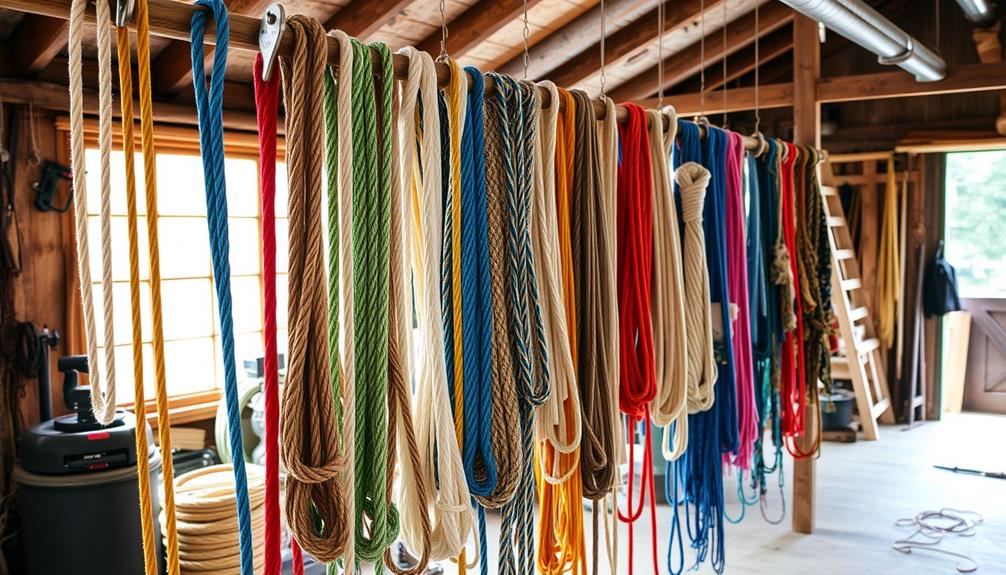To choose the best rope for any job, you'll want to reflect on material properties and specific requirements. For heavy tasks, go for Kevlar™ due to its exceptional strength. If you need something versatile, polyester holds up well in wet conditions and resists UV damage. Lightweight polypropylene is great for marine use. Remember to evaluate breaking tenacity, environmental factors, and the elasticity of the rope. Also, familiarize yourself with the right knots, as they're vital for safety and performance. By exploring further, you'll uncover other important factors that can help you make the best choice.
Key Takeaways
- Assess the specific material properties of ropes, such as strength and resistance, to match your project needs.
- Consider environmental conditions like UV exposure and moisture when selecting rope materials.
- Evaluate the required strength for your task; choose Kevlar™ for heavy loads and softer materials for lighter applications.
- Familiarize yourself with different knot types to ensure safety and effectiveness in securing loads.
- Regularly inspect and maintain ropes to extend their lifespan and ensure they remain safe for use.
Rope Material Properties
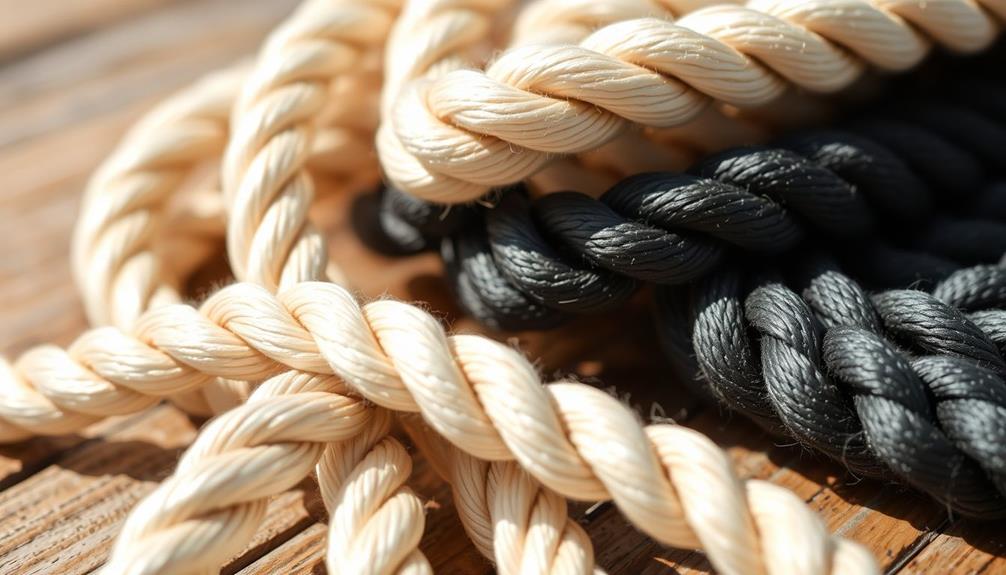
When it comes to choosing the right rope, understanding material properties is key. The type of rope you select will considerably impact your project's success.
For instance, polypropylene ropes are lightweight and UV resistant, making them perfect for marine applications. Their breaking tenacity of 7.0-9.5 g/d guarantees they're a reliable choice. Additionally, selecting ropes with optimal comfort in varying weather conditions can enhance their performance in outdoor settings.
On the other hand, while manila ropes offer aesthetic appeal and moisture absorption, they lack UV resistance and can rot over time.
If you need strong rope that can handle stress, consider nylon. It boasts a breaking tenacity of 5.0-6.0 g/d and good abrasion resistance, but remember it weakens when wet.
Polyester ropes, however, maintain their strength whether wet or dry, with a similar breaking tenacity of 7.0-9.5 g/d, making them versatile for various applications.
For high-stress scenarios, Kevlar™ ropes stand out with an impressive breaking tenacity of 18-26.5 g/d and low stretch. Regular wear checks are essential for these synthetic ropes.
Criteria for Selecting Rope
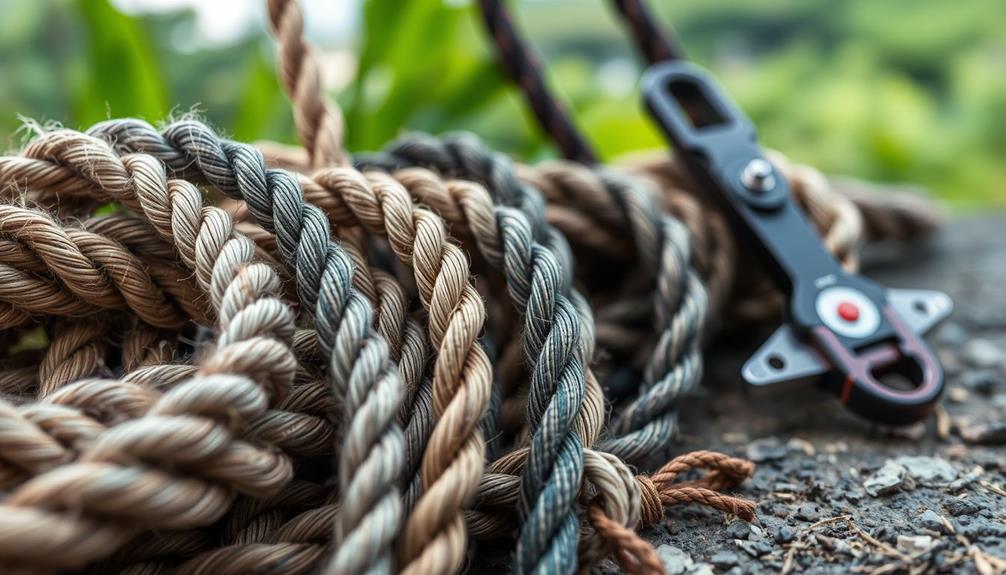
When selecting rope, you need to compare material properties and assess application suitability.
Understanding the importance of diversification strategy in your choice can help guarantee you select a rope that meets various demands, whether it's for heavy loads or marine use.
Think about the strength and resistance of different materials based on your specific needs.
Material Properties Comparison
Selecting the right rope involves understanding various material properties that impact performance in specific applications. A material properties comparison can help you identify the strengths and weaknesses of different rope types.
For instance, if you need a rope for heavy loads, consider nylon or Kevlar™, which offer superior breaking tenacity, with Kevlar™ reaching up to 26.5 g/d. Additionally, knowing how to effectively pack your gear can enhance your overall readiness in emergencies, as seen in mastering the art of bug out bags.
Water resistance is another vital factor. Polypropylene and Kevlar™ maintain their strength when wet, whereas nylon loses strength in moisture. If you're working outdoors, look for ropes with excellent UV resistance; polyester and Kevlar™ fit the bill, while natural fibers like manila can deteriorate under UV exposure.
When sudden stress is a concern, polyester excels in shock-load absorption, retaining 85-90% of its wet strength, unlike nylon, which performs poorly in this area.
Application Suitability Assessment
Choosing the right rope for your specific application hinges on several key criteria that guarantee peak performance and safety.
First, evaluate the material properties of the rope. For example, polyester is great for resisting rot and UV damage, while nylon excels in strength and abrasion resistance. Additionally, it's important to understand the risks associated with different materials, similar to how one must protect savings from scams when investing in financial products.
Next, reflect on the environmental conditions. If you're working in a marine setting, polypropylene is the best choice due to its buoyancy and UV resistance, while manila rope isn't suitable for wet conditions as it can rot.
Additionally, assess the strength requirements for your task. If you need to lift heavy loads, opt for Kevlar™ ropes, which offer exceptional breaking tenacity. On the other hand, softer ropes like cotton work well for crafting projects.
Don't forget to examine elasticity. Nylon provides high elasticity for shock absorption, while polyester maintains its strength without significant stretch in wet or dry conditions.
Lastly, if aesthetics matter, manila offers a rustic appearance, while natural fibers like cotton provide a soft touch.
All these factors contribute to your rope's overall application suitability, ensuring you make the best choice for any job.
Advantages and Disadvantages
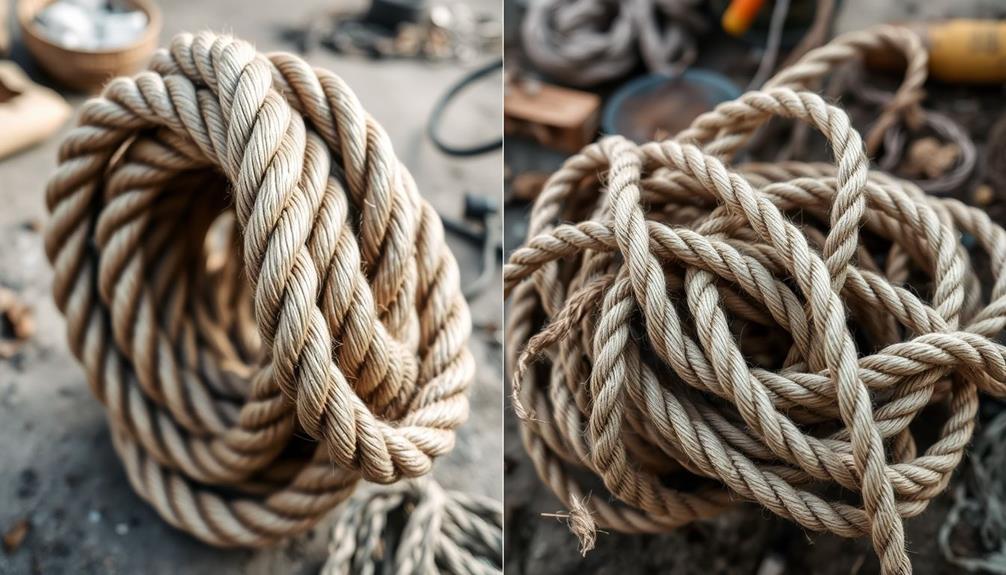
Understanding the advantages and disadvantages of different types of rope can help you make an informed decision for your specific needs. Each type of rope offers unique benefits and drawbacks that affect the handling of the rope and its performance in various situations.
Here's a quick comparison:
| Rope Type | Advantages | Disadvantages |
|---|---|---|
| Polypropylene | Lightweight, UV resistant, floats | Tends to stretch, melts under friction |
| Manila | Aesthetic appeal, moisture absorption | Not UV or water resistant, can rot |
| Nylon | Exceptional strength, abrasion resistant | Absorbs water, weakening when wet |
| Polyester | Great rot and UV resistance, strong | Can discolor in marine applications |
| Kevlar™ | Extremely strong, flame resistant | Susceptible to wear, requires regular inspection |
Rope Construction and Knots
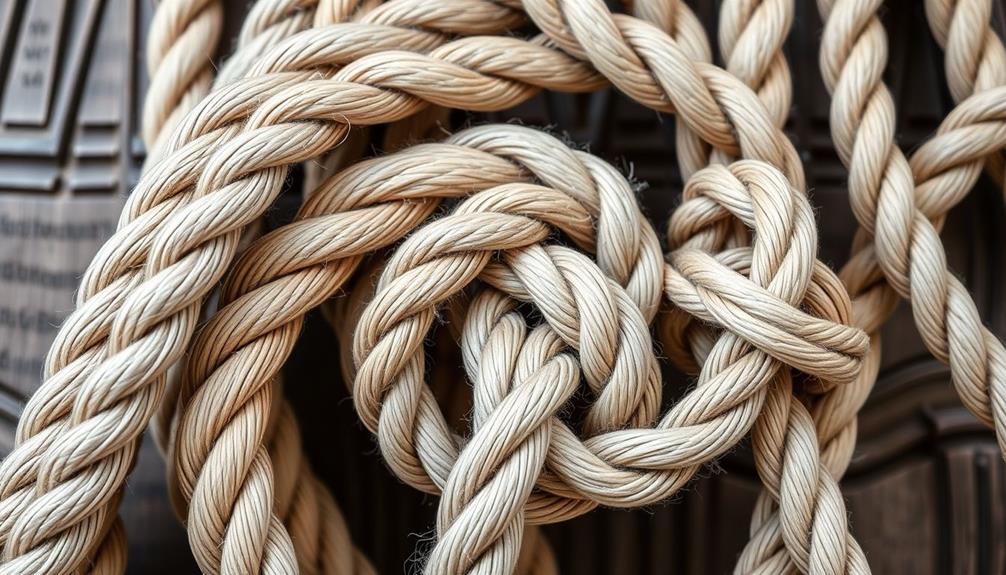
When choosing the right rope, understanding the different construction styles can make a big difference in your application.
You'll want to take into account not only the type of rope but also the knots you'll use, as each knot serves a specific purpose and has its own strengths and weaknesses.
For instance, just as selecting the right rope is vital for various tasks, essential oils for toothache relief can greatly enhance your comfort during dental discomfort.
Let's explore the key features of various rope types and how to select the best knots for your needs.
Rope Types Overview
Rope construction plays an essential role in determining its performance and suitability for specific tasks. Different types of rope come with unique advantages and disadvantages. For instance, nylon ropes are known for their excellent strength and durability, making them ideal for heavy-duty applications. Additionally, selecting energy-efficient appliances can complement tasks that require reliable equipment, ensuring that your work environment remains efficient.
On the other hand, solid braid ropes, which feature a complex braid with a filler core, provide high elongation but sacrifice some strength compared to other types.
When it comes to braided options, you'll find double braided ropes consist of a rope within a rope, allowing for even load distribution and enhanced performance. This makes them a great choice for demanding tasks. If you need a smoother surface for high-friction applications, braided ropes are your best bet.
Twisted ropes, while less expensive, mightn't perform as well under heavy strain. Additionally, understanding the different types of knots is vital for safety and effectiveness. For example, the square knot is commonly used but isn't reliable for heavy weights, while the bowline knot creates a strong loop that won't jam.
Selecting the right type of rope and knot can greatly impact your project's success.
Knot Selection Guide
Choosing the right knot is essential for guaranteeing safety and effectiveness in your projects, especially since different knots serve distinct purposes. Familiarizing yourself with various knot types can greatly improve your rope handling skills and guarantee peak knot performance when you need it most.
Here's a quick reference table to help you choose the right knot for your needs:
| Knot Type | Best Use | Performance Notes |
|---|---|---|
| Bowline | Creating a secure loop | Doesn't jam, versatile for many tasks |
| Square Knot | Joining two ropes | Not for heavy loads; can slip |
| Sheet Bend | Joining unequal ropes | Effective for different diameters |
| Slip Knot | Temporary holds | Easy to untie, but not secure for heavy loads |
Regular practice with these knots enhances your knot familiarization, guaranteeing you'll be confident and efficient in critical situations. Remember, knot performance can vary based on the rope construction style you choose, so always select a knot that complements your rope type for the best results.
Safety Guidelines and Practices
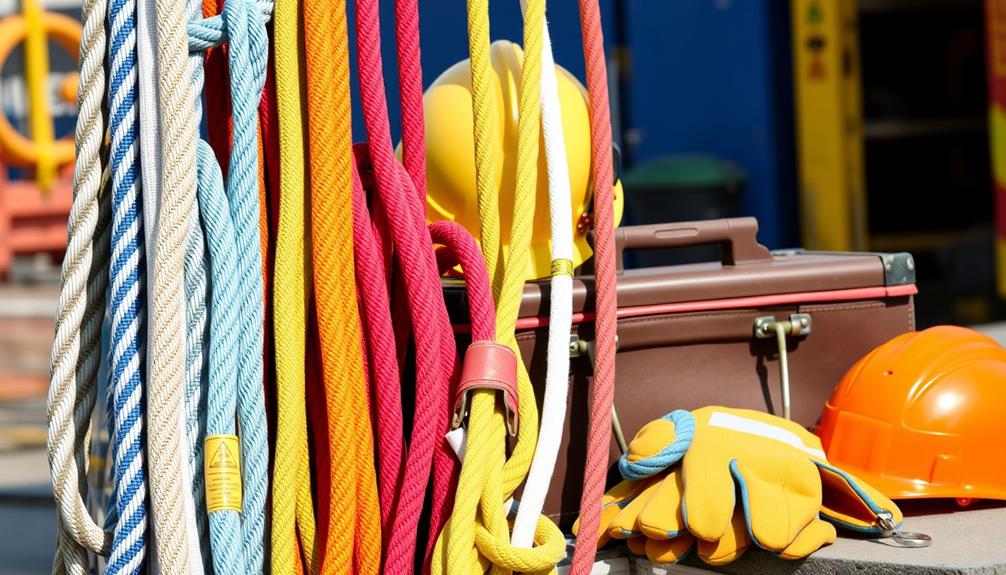
In the domain of safe rope usage, understanding the breaking tenacity and working load limits is vital to prevent accidents. Always consult these specifications before using any rope. If the load exceeds the rope's limits, you're risking failure, which can lead to serious injuries.
Regular maintenance is also important; staying informed about cold medications overview can help guarantee you're prepared for any situation.
Regularly inspect your ropes for any signs of wear, abrasions, or damage. Compromised integrity is a significant hazard, so don't skip this step.
Additionally, make sure you choose the right knots and practice proper tying techniques. Incorrect knots can slip or fail under load, increasing risk.
Be mindful of environmental factors, too. UV exposure and moisture can degrade materials like nylon and manila, reducing their effectiveness.
Always store ropes in a cool, dry place to extend their lifespan.
Applications for Different Ropes
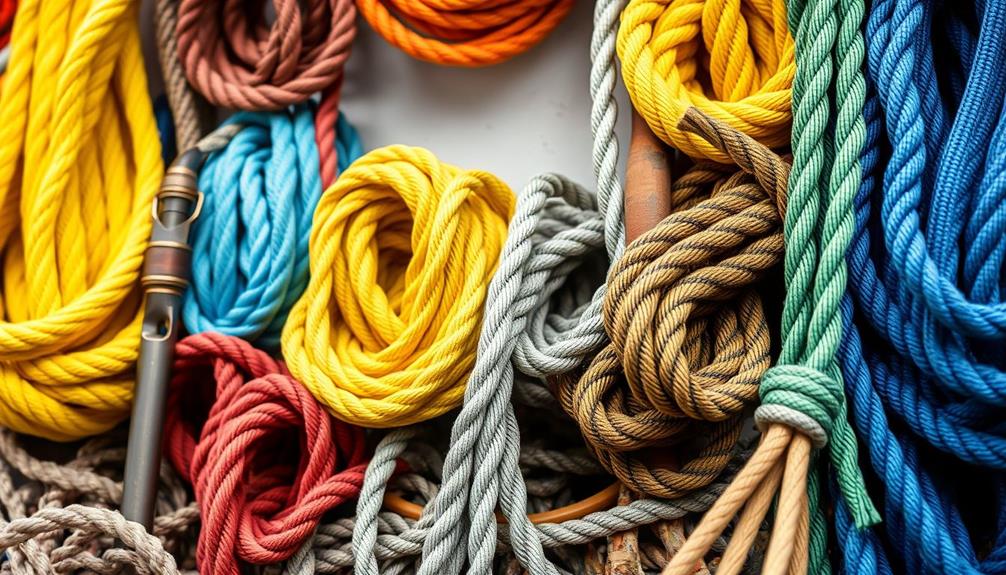
Understanding the various applications of different ropes can greatly enhance your safety and efficiency in various tasks. For marine jobs, polypropylene rope is your best bet. It's lightweight, UV resistant, and floats, making it perfect for fishing lines and buoy moorings.
Additionally, regular maintenance and cleaning of your equipment can prolong its lifespan, similar to how fuel injection cleaning improves vehicle performance. If you're dealing with heavy loads, consider nylon ropes. Their exceptional strength and abrasion resistance, combined with elasticity, make them ideal for towing and fall protection.
For rigging and winches, polyester ropes shine due to their ability to maintain strength when wet and resist rot and UV damage. They're versatile for outdoor use.
If you're looking for a rope with a natural aesthetic, manila ropes are excellent for landscaping and decorative purposes. Just remember to keep them dry to prevent rotting.
Frequently Asked Questions
Which Type of Rope Is Best for Rope Access Work?
For rope access work, you'll want to choose nylon for its strength and elasticity or polyester for wet conditions. Make certain you opt for double braided construction, prioritizing safety ratings and conducting regular inspections for wear.
How to Choose a Roping Rope?
Choosing a roping rope's like dating—don't settle for less! You want softness for finesse or durability for tough tasks. Consider moisture resistance, weight, and maintenance; they'll keep your rope as reliable as your best friend.
How Strong Rope Do I Need?
To determine how strong a rope you need, assess the maximum load you'll bear. Aim for a breaking strength that's five to ten times your expected load, ensuring safety and durability in your tasks.
What Is the Best Rope for Strength?
When it comes to strength, Kevlar™ ropes stand tall, boasting unmatched breaking tenacity. If you need something reliable for heavy loads or extreme conditions, you'll want to choose Kevlar™ for ultimate performance and safety.
Conclusion
In a world where a sturdy rope can be your lifeline—just like Odysseus relied on clever knots to navigate perilous seas—you've got the power to choose wisely. By understanding rope materials, construction, and safety practices, you're not just picking a tool; you're setting the stage for success. Whether you're climbing mountains or securing your gear, remember that the right rope can make all the difference. So, gear up, and let your adventures unfold!
